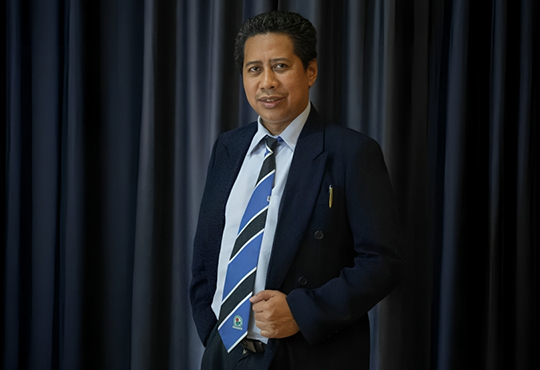How Simulation Technology is Transforming Sports Training

Ts. Abdul Halim bin Abdul Rahman, Lecturer, Department of Computing & Information Technology, Tunku Abdul Rahman University of Management and Technology (TAR UMT) in an interaction with Higher Education Review shared his views on how simulation technologies such as VR, AR, and computer modeling can be effectively integrated into traditional sports training programs to enhance performance, what specific skills such as technical, tactical, or cognitive are most improved through simulation-based training, how real-time feedback in simulations influence athlete learning, motivation, and retention of skills and more.
How can simulation technologies (VR, AR, and computer modeling) be effectively integrated into traditional sports training programs to enhance performance?
Simulation technologies like Virtual Reality (VR), Augmented Reality (AR), and computer modelling can enhance traditional sports training by making it more interactive and engaging. For example, VR can take players through virtual matches, helping them practice different situations, even when they have no opponent available. Meanwhile, AR can supply with helpful information into the real-world environment, like giving the tips or offering recommendations during training. Lastly, computer modeling can simulate various game scenarios such as the intensity of the game, different weather conditions, facing different level of opponents and many more. This integration allows athletes to train in smarter, more personalized ways, enhancing their skills without always needing a coach or partner. Let us take a look in badminton for example. These simulation technologies allow players to improve specific techniques such as shot accuracy or court positioning.
What specific skills such as technical, tactical, or cognitive are most improved through simulation-based training?
Simulation-based training can improve the technical, tactical, even the cognitive skills. I am again using the badminton as a reference since it is one of my case study in research. Technical skills, like shot accuracy, can be practiced in a controlled setting, allowing players to work on their precision without worrying about game pressure. Tactical skills, such as deciding when to attack or defend, can be sharpened by repeatedly practicing real-game situations in simulations. This might mean practicing a smash at different angles or learning to anticipate your opponent's moves in order to win the game. Do not forget, cognitive skills such as decision-making are also sharpened. For example, simulations can help players focus under pressure or make quick decisions when they are tired. Through simulations, they can learn how to stay calm and make better decisions even when the game is not favorable to them.
How does real-time feedback in simulations influence athlete learning, motivation, and retention of skills?
Real-time feedback during training is the best part of this simulation. I like to bring your imagination as a badminton player. Imagine you are practicing new serve techniques and get the feedback almost instantly. For example, the feedback might comment on your gestures. Maybe your racket angle needs some adjustment or you are hitting the shuttle too high. Getting this kind of feedback in the moment helps athletes make quick changes and avoid repeating mistakes. It also keeps them motivated because they can see the recommendations right away. In additional notes, when the players can immediately correcting their technique, they will retain the skills better. This real-time feedback makes learning feel instantaneous rather than waiting for a coach's review after the session.
In what ways can simulation help prevent injuries by analyzing biomechanics and workload management?
Simulation can help prevent injuries by tracking how athletes move and helping them avoid movements that might lead to injuries. In badminton, for example, the simulations instant feedback can identify if a player is landing improperly or using their body in a way that increases their risk of injury like putting too much strain on their knees or shoulders. These simulations can also monitor how much workload a player can handle, ensuring that they are not train too much exceeding the limits, which can lead to fatigue or injury. By adjusting training intensity based on the simulation’s feedback, athletes can train smarter and prevent physical setbacks before they happen.
What are the measurable performance outcomes of athletes who use simulation-based training compared to traditional methods?
Athletes who use simulation-based training most-likely will see noticeable improvements in their performance. For example, badminton players can see increased shot accuracy because they have practiced their techniques repeatedly in a simulation environment. The best thing about these simulations is that they can recreate real-game pressure. Meaning that the players now are able to think fast and make better decisions under stress. In contrast, traditional training methods often focus on repetitive drills without the same level of game-like pressure or feedback. Players who use simulations tend to improve their overall gameplay faster and more consistently without having to wait for real matches.
How can simulations replicate the psychological pressure and decision-making demands of real competition?
As we all know, the simulations are able to duplicate the situations similar like the real world. In this case, simulations can be used to give the athletes an experience on how to handle thepsychological pressure during real competition. By adjusting virtual game scenarios to reflect moments when a player is down in points or facing a particularly tough opponent, simulations can help athletes to handle and overcome this stress. In badminton, a player could practice shots while feeling the pressure of a crowd or a ticking clock, helping them stay calm and make better decisions in real competition. Through this kind of training, players can simulate high-intensity moments and prepare themselves to handle the real-game demands with minimum risk of losing the game.
How can simulation technologies assist in rehabilitation and return-to-play programs for injured athletes?
Simulation can be the most needed helping hand in rehabilitation and getting injured athletes back into the game safely. For the athletes who are recovering from an injury, it is important to rebuild confidence mentally and physically in their training series before returning to full-intensity training. This simulation allows them to practice basic movements and gradually build up to more intense scenarios in a controlled environment without the risk of injury. For badminton players, a simulation might help them practice footwork or shot execution while checking for any discomfort. It gives them a safe space to recover while still being able to practice and stay sharp.
What are the future trends and innovations likely to shape simulation-based sports training over the next decade?
In the next decade, we will likely see smarter, more personalized simulations that can predict exactly what an athlete needs to work on. Even at the moment, the usage of Artificial Intelligence (AI) is becoming a trend and used widely in almost everything. Same goes with these sports simulations. These systems will combine AI, VR, AR, and wearables to offer the most engaging and realistic training experiences. Virtual coaches may be able to analyze every detail of a player’s performance in terms of technical, tactical and cognitive aspects. Then the results will be used to adjust training strategies in real-time. We might also see the involvement of metaverse in the training simulation, where the athletes are able to train among themselves virtually regardless where they are. This type of sports simulation in the future will be incredibly immersive and data-driven.
What new career opportunities are emerging for professionals skilled in sports simulation technologies, such as VR/AR development, sports data analysis, and performance engineering?
As sports simulation technologies continue to evolve, there will be always a demand in this field. Some of the potential career opportunities are the VR/AR developers, who are responsible to develop the complete system to be used. They are not only responsible for the development, but also the maintenance of the systems. Another career opportunity is sports analyst. Sports analysts who specialize in interpreting performance data from simulations will also play a critical role in helping athletes maximize their potential. Apart from that, the career as a sports engineer also is needed.Sports engineers will work to build the next generation of wearable tech and biomechanical monitoring tools. And, I am pretty sure there are a lot of other career opportunities will be up for grab in this sports simulation technologies.
How can coaches, trainers, and sports scientists upskill or specialize in simulation-based training to stay competitive in the evolving sports industry?
To stay competitive, coaches, trainers, and sports scientists need to embrace simulation-based training and become familiar with new tech. Upskilling in related areas like data analysis, VR/AR tools, and biomechanics will help these professionals incorporate advanced training into their programs. Other than that, coaches and trainers can attend workshops, online courses, and conferences focused on new technologies in sports. By working closely with the people behind these technologies, they can understand how to use simulation tools to tailor training for the needs of each athlete. As sports technology continues to grow, coaches who can blend traditional expertise with cutting-edge simulation tools, including able to integrate in AI, will be more effective and in-demand.

